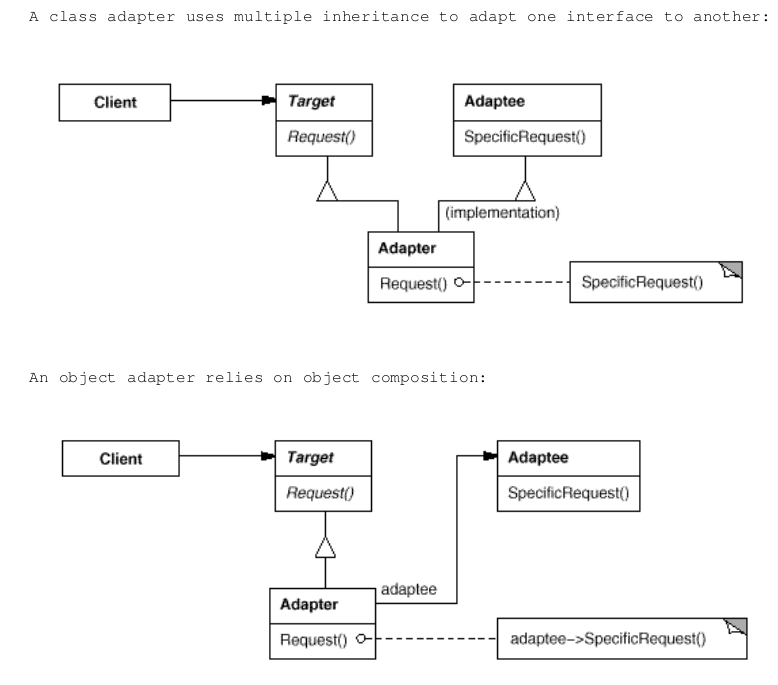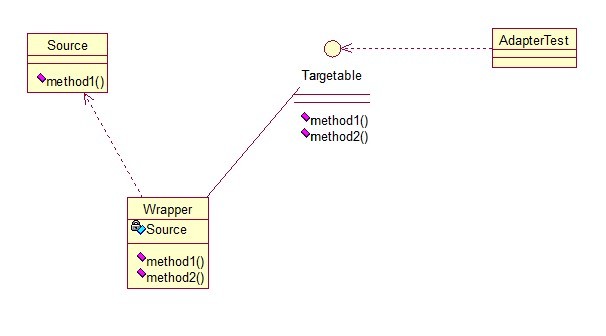6. Adapter
- Intent:
- Convert the interface of a class into another interface clients expect. Adapter lets classes work together that couldn’t otherwise because of incompatible interfaces.
- Applicability:
- you want to use an existing class, and its interface does not match the one you need.
- you want to create a reusable class that cooperates with unrelated or unforeseen classes, that is, classes that don’t necessarily have compatible interfaces.
- you need to use several existing subclasses, but it’s impractical to adapt their interface by subclassing every one. An object adapter can adapt the interface of its parent class
- Structure:

- Participants:
- Target (Shape)
- defines the domain-specific interface that Client uses.
- Client (DrawingEditor)
- collaborates with objects conforming to the Target interface.
- Adaptee (TextView)
- defines an existing interface that needs adapting.
- Adapter (TextShape)
- adapts the interface of Adaptee to the Target interface.
- Target (Shape)
- Collaborations
- Clients call operations on an Adapter instance. In turn, the adapter calls Adaptee operations that carry out the request.
- Consequences:
- A class adapter
- 1.adapts Adaptee to Target by committing to a concrete Adapter class. As a consequence, a class adapter won’t work when we want to adapt a class and all its subclasses.
- 2.lets Adapter override some of Adaptee’s behavior, since Adapter is a subclass of Adaptee.
- 3.introduces only one object, and no additional pointer indirection is needed to get to the adaptee.
- An object adapter
- 1.lets a single Adapter work with many Adaptees—that is, the Adaptee itself and all of its subclasses (if any). The Adapter can also add functionality to all Adaptees at once.
- 2.makes it harder to override Adaptee behavior. It will require subclassing Adaptee and making Adapter refer to the subclass rather than the Adaptee itself.
- A class adapter
- Issue to consider:
- 1.How much adapting does Adapter do?
- 2.Pluggable adapters?
- 3.Using two-way adapters to provide transparency.
- Related Patterns:
- Bridge has a structure similar to an object adapter, but Bridge has a different intent: It is meant to separate an interface from its implementation so that they can be varied easily and independently. An adapter is meant to change the interface of an existing object.
- Decorator enhances another object without changing its interface. A decorator is thus more transparent to the application than an adapter is. As a consequence, Decorator supports recursive composition, which isn’t possible with pure adapters
- Proxy defines a representative or surrogate for another object and does not change its interface.
- Code Sample 1: Class Adapter(extends Source)

public class Source {
public void method1() {
System.out.println("this is original method!");
}
}
public interface Targetable {
public void method1();
public void method2();
}
public class Adapter extends Source implements Targetable {
@Override
public void method2() {
System.out.println("this is the targetable method!");
}
}
public class AdapterTest {
public static void main(String[] args) {
Targetable target = new Adapter();
target.method1();
target.method2();
}
}
- Code Sample 2: Object Adapter(private Source source)

public class Wrapper implements Targetable {
private Source source;
public Wrapper(Source source){
super();
this.source = source;
}
@Override
public void method2() {
System.out.println("this is the targetable method!");
}
@Override
public void method1() {
source.method1();
}
}
public class AdapterTest {
public static void main(String[] args) {
Source source = new Source();
Targetable target = new Wrapper(source);
target.method1();
target.method2();
}
}
- Code Sample 3: Interface Adapter(interface Sourceable)
Additional Content: Interface Adapter(too many methods in the interface Sourceable)

public interface Sourceable {
public void method1();
public void method2();
}
public abstract class Wrapper2 implements Sourceable{
public void method1(){}
public void method2(){}
}
public class SourceSub1 extends Wrapper2 {
public void method1(){
System.out.println("the sourceable interface's first Sub1!");
}
}
public class SourceSub2 extends Wrapper2 {
public void method2(){
System.out.println("the sourceable interface's second Sub2!");
}
}
public class WrapperTest {
public static void main(String[] args) {
Sourceable source1 = new SourceSub1();
Sourceable source2 = new SourceSub2();
source1.method1();
source1.method2();
source2.method1();
source2.method2();
}
